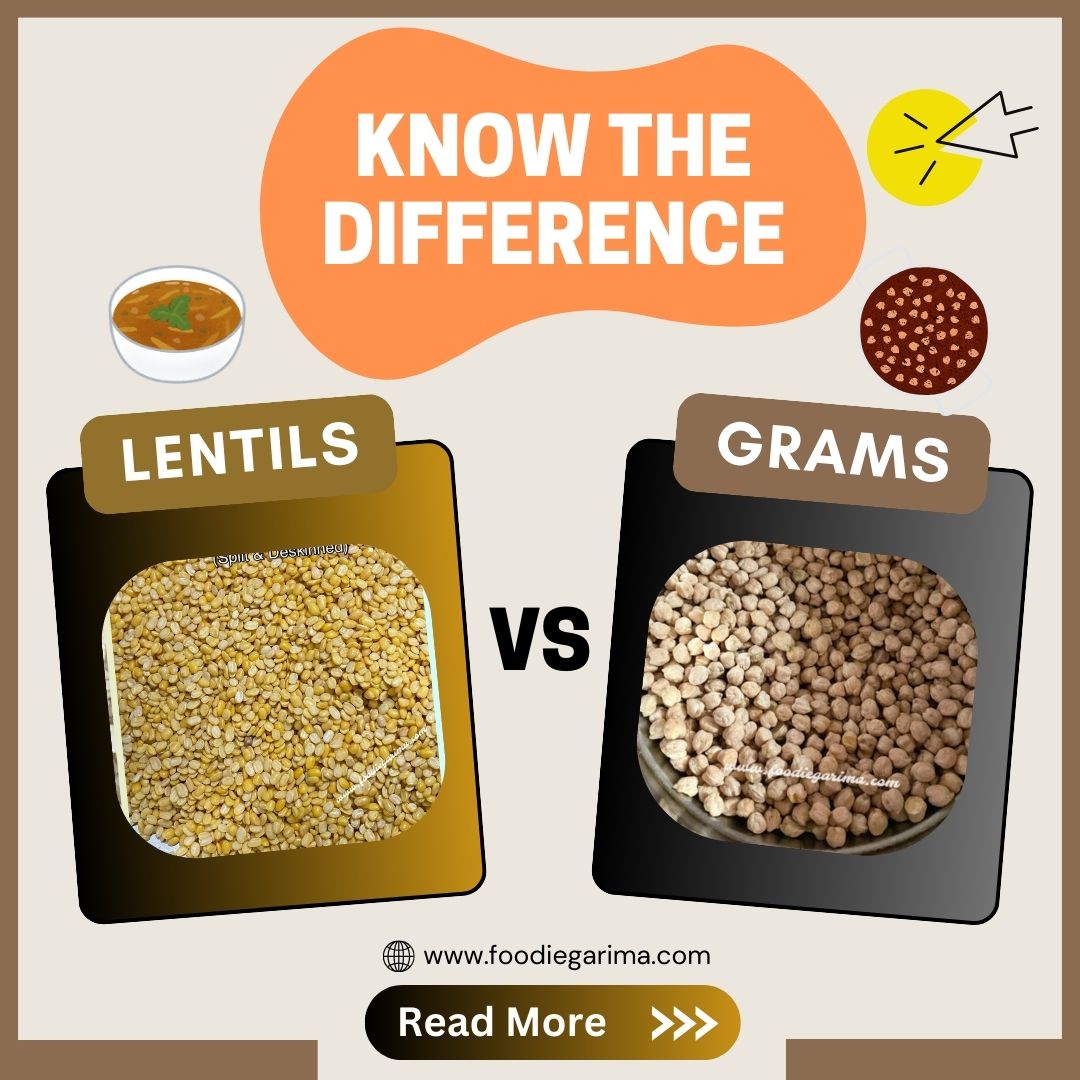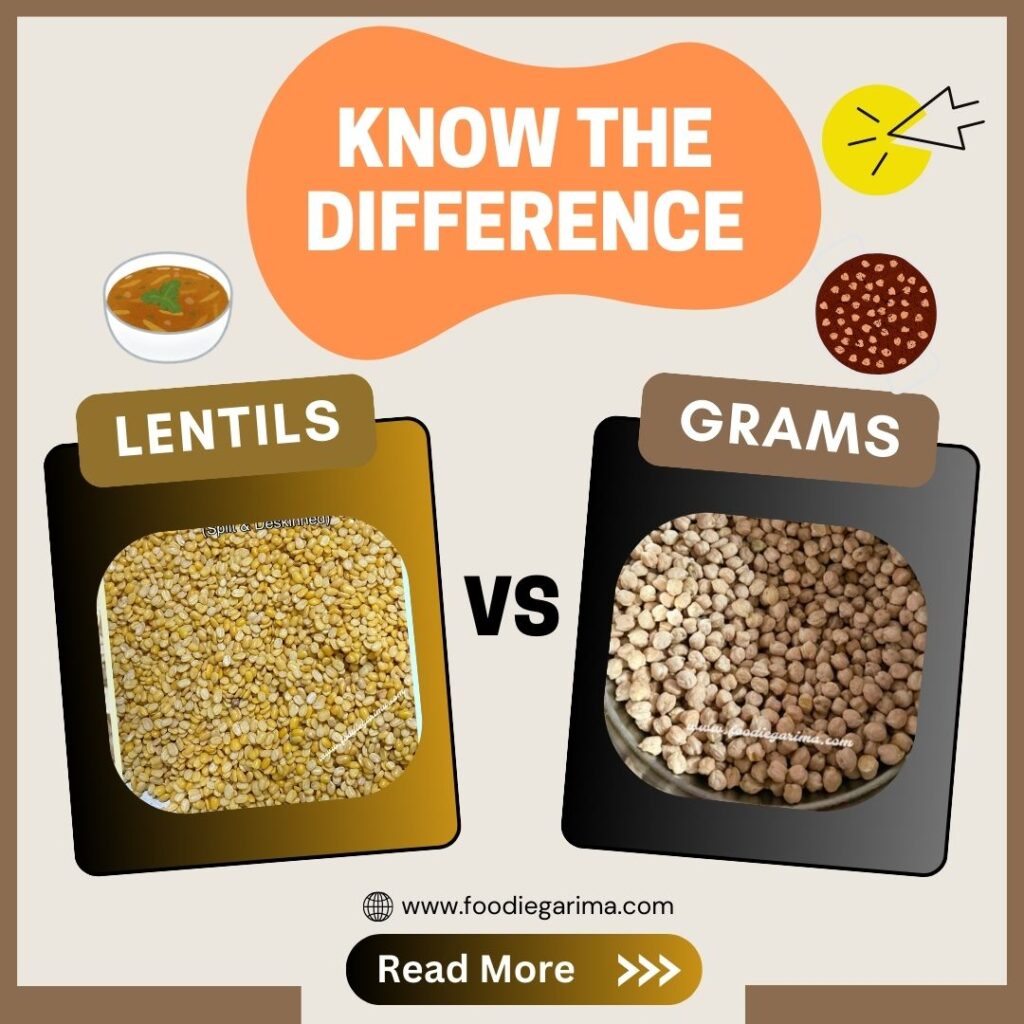8 January, 2025
Lentils vs Grams | The Differences

Lentils vs Grams
Difference Between Lentils and Grams: A Nutritional and Culinary Comparison
Lentils and Grams are staple ingredients in many cuisines, prized for their nutritional value and versatility. While they are often grouped under Pulses and Legumes, Lentils and Grams differ significantly in their characteristics, uses, and benefits. Let’s delve into their unique features and how they stand apart.
What Are Lentils?
Lentils are small, lens-shaped seeds that belong to the legume family. They are typically harvested as the seeds of the Lens culinaris plant and come in various colors and sizes.
Key Characteristics of Lentils
- Shape: Lens-shaped and flat.
- Colors: Varieties include red, green, brown, yellow, and black lentils.
- Preparation: Usually quick to cook and often do not require soaking.
- Usage: Commonly used in soups, stews, curries, and salads.
Nutritional Profile of Lentils
- Protein: High in plant-based protein, making them ideal for vegetarians and vegans.
- Fiber: Excellent source of dietary fiber, supporting digestion.
- Vitamins and Minerals: Rich in iron, folate, potassium, and magnesium.
- Low Fat: Naturally low in fat and cholesterol.
Popular Lentil Dishes
- Lentil soup
- Dal (a staple dish in South Asia)
- Lentil-based salads and patties
What Are Grams?
Grams are a specific subset of Pulses. The term “Grams” typically refers to certain Legumes, such as Chickpeas, Green Grams (mung beans), and Black Grams. They are larger and rounder compared to lentils and are widely used in whole or split form. They are commonly used in Indian and South Asian cuisines.
Key Characteristics of Grams
- Shape: Typically round or oval.
- Varieties: Include chickpeas (kabuli and desi types), green grams (mung beans), and black grams (urad dal).
- Preparation: Often require soaking before cooking.
- Usage: Frequently used in stews, curries, snacks, and flour.
Nutritional Profile of Grams
- Protein: High protein content, similar to lentils.
- Fiber: Rich in dietary fiber.
- Vitamins and Minerals: Good source of folate, zinc, and calcium.
- Complex Carbohydrates: Provide sustained energy.
Popular Gram Dishes
- Hummus (made from chickpeas)
- Sprouted green gram salad
- Urad dal dosa and idli (South Indian dishes)
Differences Between Lentils and Grams
| Feature | Lentils | Grams |
|---|---|---|
| Shape | Lens-shaped, flat | Round or oval |
| Varieties | Red, green, black, yellow, brown | Chickpeas, green grams, black grams |
| Cooking Time | Faster, often no soaking needed | Longer, soaking often required |
| Texture After Cooking | Soft and mushy | Firmer |
| Usage | Soups, salads, curries | Stews, snacks, flours |
| Nutritional Focus | Protein, fiber, folate | Protein, complex carbs, calcium |
Culinary Applications
- Lentils: Their soft texture makes them ideal for dishes like soups, purees, and curries. Red lentils, for instance, break down quickly and are perfect for creamy dals.
- Grams: With their firmer texture, grams are better suited for salads, snacks, and grinding into flour. Chickpeas are a staple for hummus and falafel, while green grams work well in sprouted salads.
Nutritional Comparison
Both lentils and grams are nutrient powerhouses, but their specific profiles make them suited for different dietary needs:
- Protein: Comparable in both, great for muscle building and repair.
- Fiber: High in both, but lentils may be slightly easier to digest.
- Iron and Folate: Lentils are particularly rich in folate, essential for red blood cell production.
- Energy: Grams provide more complex carbohydrates for sustained energy release.
Lentils and Grams each bring unique benefits to the table. Lentils are quick-cooking and ideal for creamy, soft dishes, while Grams excel in firmer, textured preparations like salads and snacks. Incorporating both into your diet ensures a diverse intake of nutrients, flavors, and textures.
FAQs
1. Are lentils and grams the same?
No, lentils are lens-shaped seeds, while grams are rounder and larger legumes.
2. Do lentils require soaking?
Most lentils do not need soaking and cook faster than grams.
3. Which is more nutritious: lentils or grams?
Both are highly nutritious, but lentils are rich in folate, while grams provide more complex carbohydrates.
4. Can grams be sprouted like lentils?
Yes, grams like green grams are excellent for sprouting and are highly nutritious in this form.
5. What are common dishes made from lentils and grams?
Lentils are used in soups and dals, while grams are used in hummus, sprouted salads, and snacks like falafel.
